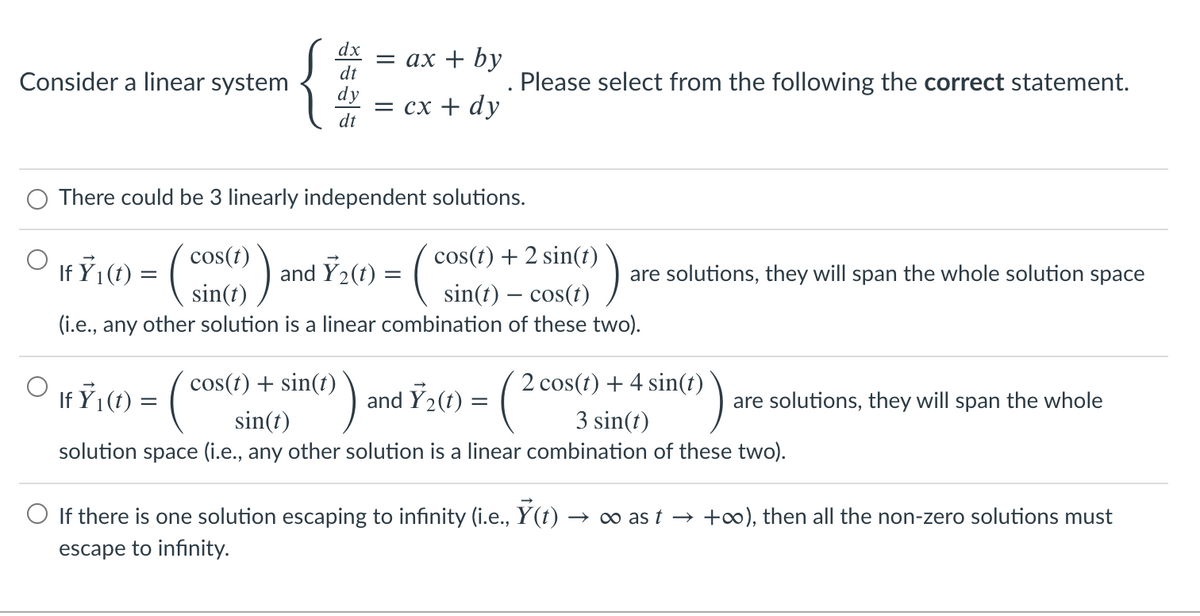dx — ах + bу dt Consider a linear system Please select from the following the correct statement. dy — сх + dy dt There could be 3 linearly independent solutions. cos(t) cos(t) + 2 sin(t) and Y2(t) = ( are solutions, they will span the whole solution space sin(t) – cos(t) (i.e., any other solution is a linear combination of these two). sin(t) - cos(t) + sin(t) 2 cos(t) + 4 sin(t) and Y2(1) = are solutions, they will span the whole sin(t) 3 sin(t) solution space (i.e., any other solution is a linear combination of these two). O If there is one solution escaping to infinity (i.e., Y(t) → o as t → +∞), then all the non-zero solutions must escape to infinity.
dx — ах + bу dt Consider a linear system Please select from the following the correct statement. dy — сх + dy dt There could be 3 linearly independent solutions. cos(t) cos(t) + 2 sin(t) and Y2(t) = ( are solutions, they will span the whole solution space sin(t) – cos(t) (i.e., any other solution is a linear combination of these two). sin(t) - cos(t) + sin(t) 2 cos(t) + 4 sin(t) and Y2(1) = are solutions, they will span the whole sin(t) 3 sin(t) solution space (i.e., any other solution is a linear combination of these two). O If there is one solution escaping to infinity (i.e., Y(t) → o as t → +∞), then all the non-zero solutions must escape to infinity.
Advanced Engineering Mathematics
10th Edition
ISBN:9780470458365
Author:Erwin Kreyszig
Publisher:Erwin Kreyszig
Chapter2: Second-order Linear Odes
Section: Chapter Questions
Problem 1RQ
Related questions
Question

Transcribed Image Text:{
dx
— ах + by
dt
Consider a linear system
Please select from the following the correct statement.
dy
— сх + dy
dt
There could be 3 linearly independent solutions.
cos(t)
cos(t) + 2 sin(t)
If Y1(1) =
*) and Ya(1) =
are solutions, they will span the whole solution space
sin(t) – cos(t)
(i.e., any other solution is a linear combination of these two).
sin(t)
cos(t) + sin(t)
Ý20) = (
3 sin(1)
2 cos(t) + 4 sin(t)
If Y1(1) =
") and Y2(0) =
are solutions, they will span the whole
sin(t)
solution space (i.e., any other solution is a linear combination of these two).
If there is one solution escaping to infinity (i.e., Y(t) → ∞ as t → +∞), then all the non-zero solutions must
escape to infinity.
Expert Solution
This question has been solved!
Explore an expertly crafted, step-by-step solution for a thorough understanding of key concepts.
Step by step
Solved in 3 steps with 1 images

Recommended textbooks for you

Advanced Engineering Mathematics
Advanced Math
ISBN:
9780470458365
Author:
Erwin Kreyszig
Publisher:
Wiley, John & Sons, Incorporated

Numerical Methods for Engineers
Advanced Math
ISBN:
9780073397924
Author:
Steven C. Chapra Dr., Raymond P. Canale
Publisher:
McGraw-Hill Education

Introductory Mathematics for Engineering Applicat…
Advanced Math
ISBN:
9781118141809
Author:
Nathan Klingbeil
Publisher:
WILEY

Advanced Engineering Mathematics
Advanced Math
ISBN:
9780470458365
Author:
Erwin Kreyszig
Publisher:
Wiley, John & Sons, Incorporated

Numerical Methods for Engineers
Advanced Math
ISBN:
9780073397924
Author:
Steven C. Chapra Dr., Raymond P. Canale
Publisher:
McGraw-Hill Education

Introductory Mathematics for Engineering Applicat…
Advanced Math
ISBN:
9781118141809
Author:
Nathan Klingbeil
Publisher:
WILEY

Mathematics For Machine Technology
Advanced Math
ISBN:
9781337798310
Author:
Peterson, John.
Publisher:
Cengage Learning,

